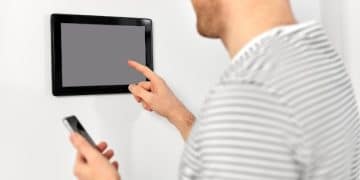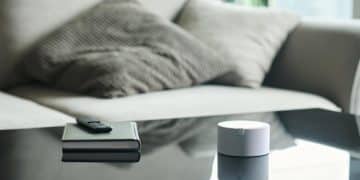Smart Home Security Cameras: Protect Your Property Now
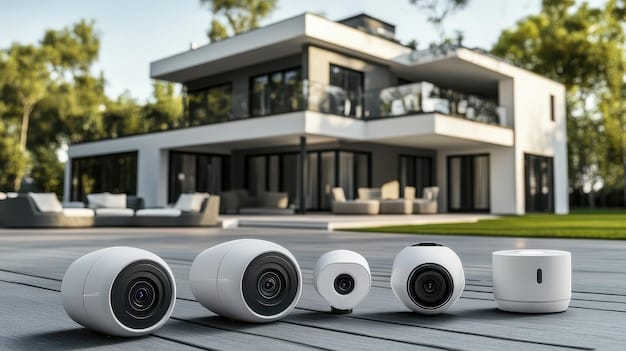
Smart home security cameras offer an advanced surveillance solution, allowing homeowners in the US to protect their property by remotely monitoring their homes, deterring potential threats, and providing valuable evidence in case of incidents.
Investing in smart home security cameras: protect your property with advanced surveillance is a proactive step towards safeguarding your home and family in the US. These cameras provide real-time monitoring, deter potential intruders, and offer peace of mind whether you’re at home or away.
Understanding Smart Home Security Cameras
Smart home security cameras are internet-connected devices that allow you to monitor your property remotely using a smartphone, tablet, or computer. They are a key component of a smart home security system, offering advanced features like motion detection, night vision, and two-way audio.
These cameras can be used to monitor indoor areas, such as living rooms and entryways, or outdoor areas, such as front doors, backyards, and driveways. With the ability to record and store footage, smart home security cameras provide valuable evidence in case of a break-in or other incident.
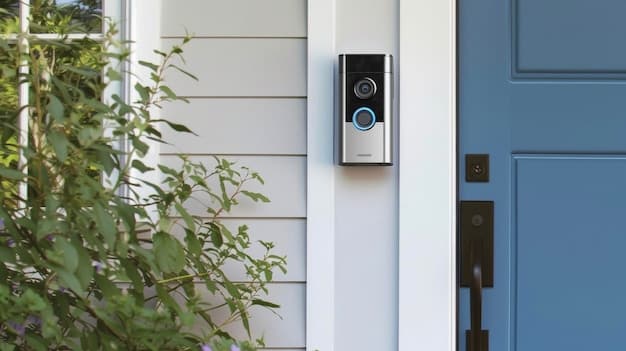
Benefits of Smart Home Security Cameras
There are numerous benefits to using smart home security cameras. These include:
- Remote Monitoring: View live video footage of your property from anywhere with an internet connection.
- Deterrence: Visible cameras can deter potential intruders and prevent crimes.
- Evidence: Record footage for use in investigations or insurance claims.
- Peace of Mind: Knowing your home is being monitored can provide a sense of security and comfort.
Smart home security cameras offer a comprehensive solution for protecting your property and loved ones. They are an essential tool for any homeowner looking to enhance their security.
In summary, smart home security cameras provide a range of benefits, from remote monitoring to deterring crime and providing valuable evidence. Understanding their capabilities is the first step in creating a safer home environment.
Key Features to Look for in Smart Security Cameras
When selecting smart home security cameras, consider several key features to ensure they meet your specific needs. These features can significantly impact the effectiveness and usability of your security system.
Resolution, field of view, night vision, and storage options are crucial factors to evaluate when choosing the right camera for your home.
Resolution
The resolution of a security camera determines the clarity of the video footage. Higher resolution cameras provide sharper images, making it easier to identify details such as faces and license plates. Look for cameras with at least 1080p resolution for optimal clarity.
Field of View
The field of view (FOV) refers to the area that the camera can see. A wider FOV allows you to cover more ground with a single camera. Consider cameras with a wide-angle lens to maximize coverage.
- Night Vision: Ensure the camera has infrared (IR) night vision for clear footage in low-light conditions.
- Motion Detection: Look for cameras with customizable motion detection zones to reduce false alarms.
- Two-Way Audio: Cameras with two-way audio allow you to communicate with visitors or deter intruders remotely.
Choosing a camera with the right features can greatly enhance your home security system. Consider the resolution, field of view, and other features to find the best camera for your needs.
Ultimately, selecting smart home security cameras with the right features can provide enhanced security and peace of mind. Prioritize features that align with your specific needs to ensure the effectiveness of your security system.
Types of Smart Home Security Cameras
Smart home security cameras come in various types, each designed for specific purposes and locations. Understanding the different types can help you choose the right cameras for your home.
Indoor cameras, outdoor cameras, and doorbell cameras each serve unique functions in a comprehensive smart home security system.
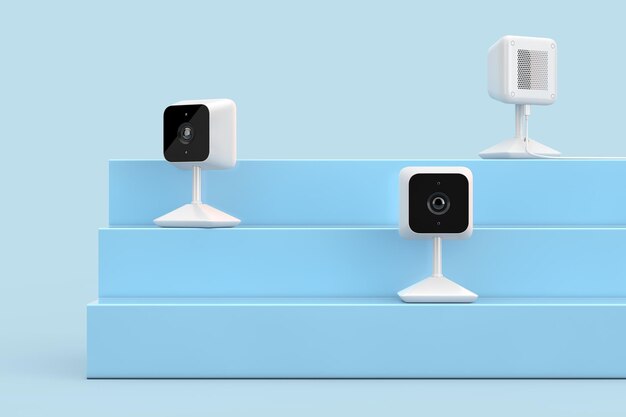
Indoor Cameras
Indoor cameras are designed for monitoring the inside of your home. They can be placed on shelves, mounted on walls, or hidden discreetly. Indoor cameras are often used to keep an eye on children, pets, or elderly family members.
Outdoor Cameras
Outdoor cameras are built to withstand the elements and monitor the exterior of your property. They typically have weather-resistant housings and can be mounted on walls, eaves, or poles. Outdoor cameras are commonly used to monitor front doors, backyards, and driveways.
- Doorbell Cameras: These cameras replace your existing doorbell and allow you to see and speak to visitors remotely.
- Wireless Cameras: Wireless cameras connect to your home network via Wi-Fi, making them easy to install and move.
- Wired Cameras: Wired cameras provide a more reliable connection and are less susceptible to interference.
Different types of smart home security cameras offer distinct advantages for various monitoring needs. Choosing the right combination can create a comprehensive and effective security system.
In conclusion, selecting the appropriate type of smart home security camera is crucial for tailoring your security system to your specific needs. Whether it’s for indoor monitoring, outdoor surveillance, or doorbell functionality, each type offers unique benefits.
Installation and Setup Tips
Proper installation and setup are essential for maximizing the effectiveness of your smart home security cameras. Following these tips can help ensure a smooth and successful installation process.
Choosing the right location, connecting to your home network, and configuring settings are all critical steps in setting up your cameras.
Choosing the Right Location
Placement is key when installing security cameras. Consider the areas you want to monitor and choose locations that provide a clear view of those areas. Avoid placing cameras in direct sunlight or areas with obstructions.
Connecting to Your Home Network
Most smart home security cameras connect to your home network via Wi-Fi. Ensure you have a strong Wi-Fi signal in the areas where you plan to install the cameras. Follow the manufacturer’s instructions for connecting the camera to your network.
- Configuring Settings: Customize the camera settings to meet your specific needs.
- Motion Detection Zones: Set up motion detection zones to reduce false alarms.
- Alerts and Notifications: Configure alerts and notifications to receive real-time updates on your smartphone or tablet.
By following these installation and setup tips, you can ensure that your smart home security cameras are functioning properly and providing the protection you need.
In summary, proper installation and setup of smart home security cameras involve careful planning and configuration. Choosing the right location, connecting to your home network, and customizing settings are crucial for optimal performance.
Integrating with Other Smart Home Devices
Smart home security cameras can be integrated with other smart home devices to create a comprehensive security system. This integration allows you to automate tasks and control multiple devices from a single app.
Integrating with smart locks, smart lighting, and security systems can enhance your home’s security and convenience.
Smart Locks
Smart locks allow you to remotely lock and unlock your doors using a smartphone. Integrating smart locks with your security cameras allows you to verify who is at the door before unlocking it.
Smart Lighting
Smart lighting can be programmed to turn on automatically when motion is detected by your security cameras. This can deter intruders and provide additional visibility.
- Security Systems: Integrate your security cameras with a professional monitoring service for 24/7 protection.
- Voice Assistants: Use voice commands to control your security cameras and other smart home devices.
- IFTTT: Use IFTTT (If This Then That) to create custom automations between your security cameras and other devices.
Integrating your smart home security cameras with other smart home devices can create a more secure and convenient living environment.
In essence, integrating smart home security cameras with other devices enhances both security and convenience. Smart locks, lighting, and comprehensive security systems all contribute to a smarter, safer home.
Maintaining and Troubleshooting Your Security Cameras
Regular maintenance and troubleshooting are essential for ensuring the long-term reliability of your smart home security cameras. Following these tips can help you keep your cameras in optimal working condition.
Cleaning the lens, checking the connection, and updating firmware are crucial aspects of maintaining your security cameras.
Cleaning the Lens
Dust, dirt, and smudges can impair the image quality of your security cameras. Clean the lens regularly with a soft, lint-free cloth.
Checking the Connection
Ensure that your security cameras are connected to your home network and that the connection is stable. Check the Wi-Fi signal strength and troubleshoot any connectivity issues.
- Updating Firmware: Keep your camera’s firmware up to date to ensure optimal performance and security.
- Troubleshooting Common Issues: Refer to the manufacturer’s documentation for troubleshooting tips and solutions to common issues.
- Replacing Batteries: If your camera is battery-powered, replace the batteries regularly to ensure uninterrupted operation.
By performing regular maintenance and troubleshooting, you can keep your smart home security cameras functioning properly and providing the protection you need.
In conclusion, maintaining and troubleshooting smart home security cameras involves routine tasks like cleaning the lens, ensuring a stable connection, and updating firmware. These practices ensure long-term reliability and optimal performance.
| Key Point | Brief Description |
|---|---|
| 🛡️ Deterrence | Visible cameras discourage potential intruders from targeting your property. |
| 📹 Evidence | Recorded footage can be used in investigations and for insurance claims. |
| 📱 Remote Access | Monitor your home from anywhere using your smartphone or tablet. |
| 💡 Integration | Connect with smart locks and lighting for enhanced automation. |
Frequently Asked Questions
▼
Smart cameras connect to your home’s Wi-Fi, recording and transmitting footage to a secure cloud server. You can access the live feed and recordings via a smartphone app or web browser.
▼
Aim for at least 1080p resolution for clear and detailed footage. Higher resolutions like 2K or 4K provide even sharper images, improving identification of details.
▼
Yes, many cameras offer local storage options via SD cards, allowing you to avoid monthly subscription fees. However, cloud storage provides added security and convenience.
▼
Customize motion detection zones to focus on specific areas and reduce alerts from pets or passing cars. Adjust sensitivity settings to minimize false positives.
▼
Modern wireless cameras use encryption to protect your data. Ensure your home Wi-Fi is secure by using a strong password and enabling WPA3 encryption for added protection.
Conclusion
Investing in smart home security cameras: protect your property with advanced surveillance is a wise decision for any homeowner looking to enhance their security and peace of mind. By understanding the different types of cameras, key features, and installation tips, you can create a comprehensive security system that meets your specific needs and provides real-time monitoring, deterrence, and valuable evidence in case of incidents.



